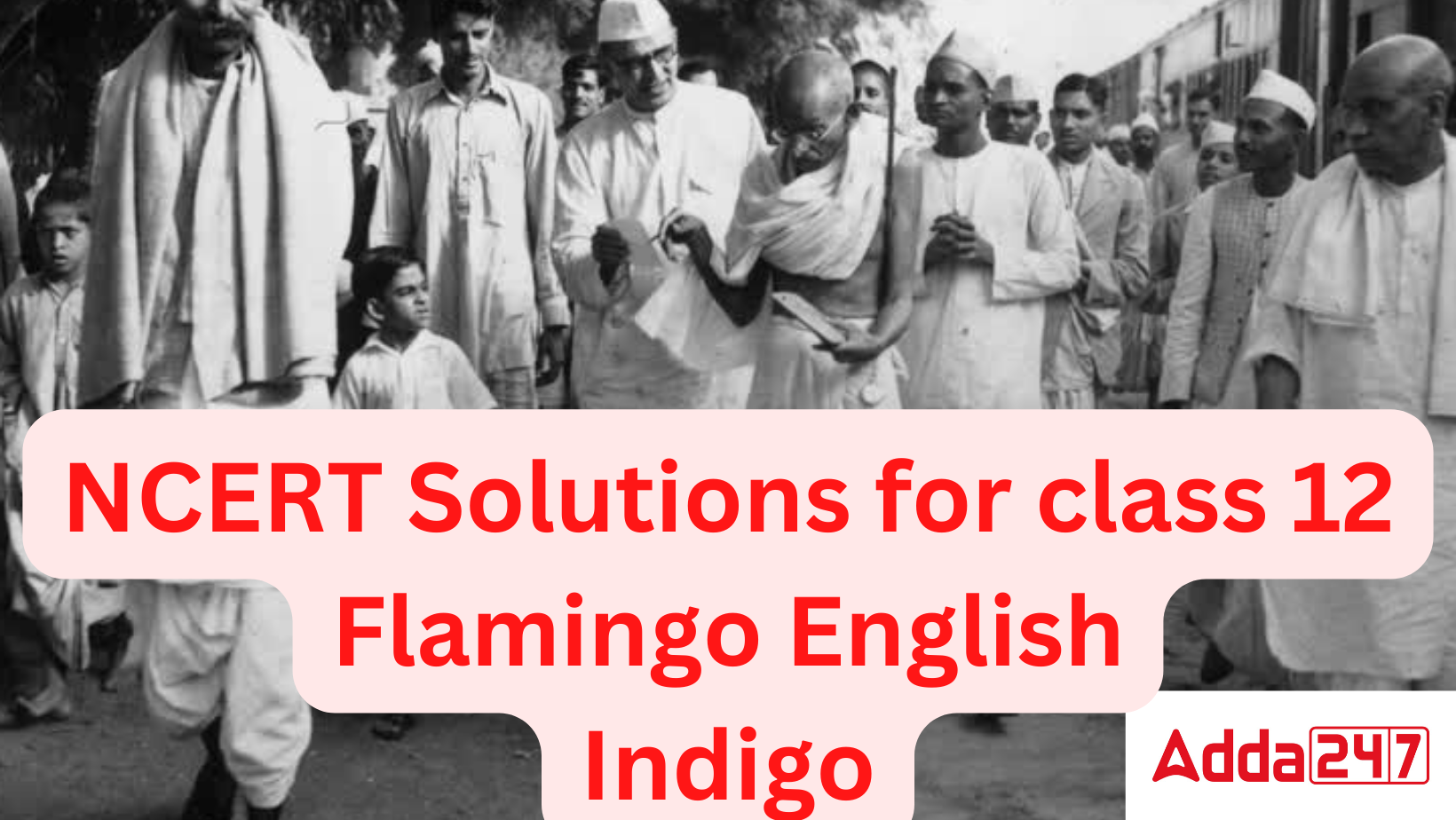Indigo Class 12 Questions and Answers for Chapter 5: Introduction
The story is based on an interview Louis Fischer conducted with Mahatma Gandhi. He visited him in 1942 at his ashram, Sevagram, where he learned about the Indigo Movement that Gandhiji had launched in order to write a book about him. The plot centres on Gandhi’s and other notable figures’ fight to protect sharecroppers from the cruelties of landowners.
Online Live Classes for CBSE BOARD CLASS 12TH
NCERT Solutions for Class 12 English Flamingo Chapter 5 Indigo: Video Explanation
Indigo Class 12 Questions and Answers: PDF
NCERT Solutions for Class 12 English Flamingo Chapter 5 Indigo are available in a PDF format on Adda247
Indigo Question Answers for Chapter 5 of Class 12
Page no. 46
Q: Notice these expressions in the text. Infer their meanings from the context.
- urge the departure – insist on the going away of the British from India
- conflict of duties – clash of obligation or responsibility
- harbor a man like me – give shelter to an advocate of home-rule
- seek a prop – try to find support or assistance
Page no. 47
Think as you read
Q1. Strike out what is not true in the following:
(a)Rajkumar Shukla was:
(i)a sharecropper (ii)a politician
(iii)delegate (iv)a landlord.
Ans: (ii) a politician
(b) Rajkumar Shukla was:
(i) poor (ii)physically strong
(iii) illiterate.
Ans: (ii) physically strong
Q2. Why is Rajkumar Shukla described as being ‘resolute’?
Ans: He had travelled a long distance to meet Gandhi in Lucknow from the Champaran district in the foothills of the Himalayas. Gandhi was escorted everywhere by Shukla. Shukla went with him to an ashram not far from Ahmedabad. He stayed at Gandhi’s side for weeks until Gandhi requested him to meet at Calcutta.
Q3. Why do you think the servants thought Gandhi to be another peasant?
Ans: Gandhi was accompanied by Shukla to Rajendra Prasad’s home. Shukla was known to the servants as a meagre yeoman. Gandhi also wore a straightforward dhoti. He was a peasant’s buddy. Gandhi was therefore misunderstood by the servants as another peasant.
Page no. 49
Think as you read
Q1. List the places that Gandhi visited between his first meeting with Shukla and his arrival at Champaran.
Ans: In Lucknow, Gandhi and Shukla met first. He thereafter travelled to Cawnpore and other locations in India. He went back to his ashram in the Ahmedabad region. He visited Calcutta, Patna, and Muzaffarpur after that, then travelled to Champaran.
Q2. What did the peasants pay the British landlords as rent? What did the British now want instead and why? What would be the impact of synthetic indigo on the prices of natural indigo?
Ans: The peasants paid indigo as rent to the British Landlords. Now Germany had developed synthetic indigo. So, the British landlords wanted money as compensation for being released from the 15 percent arrangement. The prices of natural indigo might go down due to synthetic Indigo.
Page no. 51
Think as you read
Q1. The events in this part of the text illustrate Gandhi’s method of working. Can you identify some instances of this method and link them to his ideas of Satyagraha and non-violence?
Ans: Gandhi’s politics were intertwined with the common issues faced by the numerous millions of Indians. He objected to unfair legislation. He was willing to risk arrest and imprisonment for violating such laws. Another example is the infamous Dandi March, which broke the “salt law.” The peaceful opposition and disobedience was an effort to pursue justice and the truth. This was strongly related to his nonviolent resistance and Satyagraha ideologies.
Page no. 53
Think as you read
Q1. Why did Gandhi agree to a settlement of 25 per cent refund to the farmers?
Ans: The fact that the landlords were made to return some of the money and, along with it, some of their status, was more significant to Gandhi than the exact amount of the refund. He consequently consented to a settlement of a 25% refund to the farmers.
Q2. How did the episode change the plight of the peasants?
Ans: The peasants were saved from spending time and money on court cases. After some years the British planters gave up control of their estates. These now reverted to the peasants. Indigo sharecropping disappeared.
Page no. 54
Understanding the text
Q1. Why do you think Gandhi considered the Champaran episode to be a turning-point in his life?
Ans: Because it was India’s first Satyagraha movement and because it gave the Champaran peasants back their spirit and sense of independence, Gandhi saw the Champaran episode as a turning point in his life. Gandhi saw it as important to his life and the development of Indian freedom as a result.
Q2. How was Gandhi able to influence lawyers? Give instances.
Ans: Gandhi was able to influence the lawyers by setting a good example. Gandhi didn’t have any problem to spend time in prison for the sake of the peasants. This prompted them to remain in Champaran and volunteer to accompany him to jail if he was arrested.
Q3. What was the attitude of the average Indian in smaller localities towards advocates of ‘home rule’?
Ans:The common Indian in smaller towns and villages at the time was afraid of the British. They were worried about the consequences of helping “home rule” proponents. They were so reluctant to publicly show their support for Gandhi and only a select few ventured to do so. In the narrative, we come across characters like Professor Malkani, who had the guts to provide Gandhi with refuge during his visit to Muzaffarpur.
Q4. How do we know that ordinary people too contributed to the freedom movement?
Ans: We know that ordinary people helped the freedom movement in the following ways.
Thousands of poor peasants took part in spontaneous demonstrations around the courthouse in Motihari. Owing to his tenacity, an ordinary peasant named Rajkumar Shukla spearheaded this movement. This resulted in India’s first Satyagraha movement, which contributed to the freedom movement.
In Champaran, Mahadev Desai, and Narhari Parikh, two young men who had recently become disciples of Gandhi, and their wives volunteered to teach in a school. Champaran’s social and cultural backwardness was alleviated as a result of this. A doctor also volunteered for six months in Champaran.
Page no. 55
Talking about the text
Discuss the following:
Q1. “Freedom from fear is more important than legal justice for the poor.” Do you think that the poor of India are free from fear after Independence?
Answer:
Gandhi stated in this story that the true relief for the poor peasants is to be free of fear.
Even after independence, poor literacy rates, a lack of adequate nutrition, and a lack of access to sanitary facilities continue to plague India’s poor. Even though many government measures and schemes have been implemented, a lack of awareness of such schemes leads to the underutilization of these helpful measures.
However, a new trend has recently emerged. Non-governmental organizations, private companies as part of their corporate social responsibility (CSR) programs, and concerned individuals have all pitched in their community to ensure and uplift the standard and quality of life for the poor and disadvantaged groups. The poor of India will be free of fear as people help one another and develop self-reliance and courage.
Q2. The qualities of a good leader.
Ans: Self-awareness, credibility, relationship-building, a bias for action, humility, empowerment of others, authenticity, presenting themselves as constant and consistent, becoming role models, and being completely present are all qualities of good leaders.











 NCERT Solutions for Class 12 Chemistry C...
NCERT Solutions for Class 12 Chemistry C...
 Class 12 Chemistry Chapter 9 NCERT Solut...
Class 12 Chemistry Chapter 9 NCERT Solut...
 Class 12 Chemistry Chapter 8 NCERT Solut...
Class 12 Chemistry Chapter 8 NCERT Solut...

